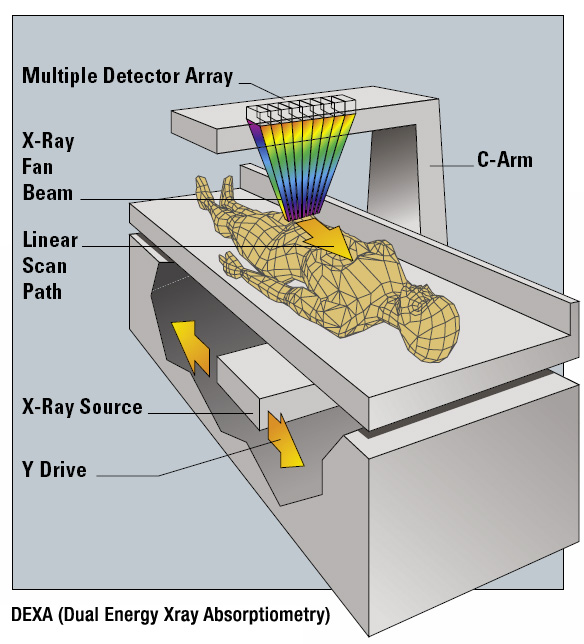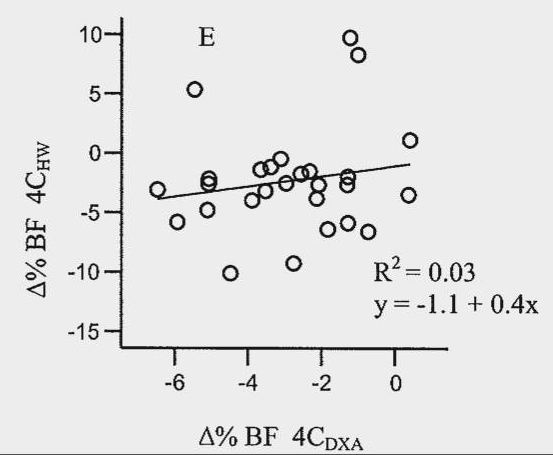In the first five parts of this series, I discussed various 2-compartment models of estimating body composition. These models divide the body into fat and fat-free mass. Now let's talk about a common 3-compartment model: dual-energy x-ray absorptiometry (DEXA).
DEXA
DEXA, once used for determining bone density, evolved into a technique for also estimating body composition. DEXA represents a 3-compartment model for estimating body composition, because it can divide the body into 3 compartments: fat, bone mineral, and all other fat-free mass that does not include bone. Thus, unlike 2-compartment models, DEXA is not subject to errors caused by variations in bone density among different ethnicities. However, there are other sources of error which I will discuss in this article.
DEXA offers a number of advantages. Improved technology has dramatically decreased scan times (years ago, a DEXA scan would take 20-25 minutes; now scans can take 5-10 minutes), so the method is convenient and non-invasive. DEXA can provide bone density estimates, and can provide regional estimates of body composition (meaning it can estimate the body composition of individual parts of your body). DEXA works by measuring your body's absorbance of x-rays at two different energies. Fat, bone mineral, and fat-free soft tissue have different absorption properties. Thus, we can get estimates of your body composition by scanning your entire body.
DEXA Sources of Error
Like all other body fat estimation techniques, DEXA has numerous sources of error. There can be inconsistent results between different machines from different manufacturers, and even different results between machines from the same manufacturer. Software upgrades can change the algorithms that the device uses to calculate body composition. Different hardware and software configurations can result in different interpolations of soft tissue over bone, and different treatment of pixels of which a small portion is bone. The type of X-ray beam (fan beam or pencil beam) can also be a source of error; DEXA machines with fan beams can suffer from beam magnification (also known as parallax error). A final source of error is the same error that all 2-compartment models also have: the hydration of fat-free mass. In fact, a 5% variation in fat-free mass hydration can change your DEXA-determined body fat percentage by nearly 3%. This can be a problem when comparing different ethnicities or body types where fat-free mass hydration can vary. It can also be a problem when trying to measure change over time.
DEXA vs. 4-Compartment Models
A number of studies have compared DEXA to 4-compartment models. When looking at group averages, DEXA does pretty well, with errors of 1-2%. However, like with all other body fat testing techniques, individual error rates can be much higher. The error rates vary by what study you look at and which DEXA machine was used; error rates range from 4% in one study to up to 8-10% in another study. Also, the accuracy of DEXA can be affected by sex, size, fatness, and disease state of subjects.
There are also issues when trying to use DEXA for tracking change over time. In one study, researchers wrapped lard around the legs of subjects to simulate weight gain. However, this changed the apparent bone mineral content, questioning the ability of DEXA to accurately assess body composition during weight change. In another study on bodybuilders, DEXA was reasonably accurate when looking at the group change in body fat percentage, but the individual error rate was as high as 4%. Thus, you could decrease your body fat percentage by 4% yet DEXA might show no change, or DEXA might show a 4% change when you didn't really have a change. Another study showed DEXA to overestimate decreases in percent body fat, while it underestimated increases in percent body fat. In fact, the overestimations got as high as 5%. Finally, here's a chart from a study that compared changes in body fat over time using DEXA to using a 4-compartment model:
The X-axis of this chart shows the change in % body fat for DEXA, while the Y-axis shows the change for the 4-compartment model. You can see there was very little agreement between the methods. For example, one person showed an increase in body fat percentage by 5% with the 4-compartment model, but a decrease by 5% according to DEXA. Another person had nearly a 10% loss of body fat according to the 4-compartment model, but only a 3% decrease according to DEXA. These results question the reliability of DEXA for measuring change over time in individuals.
DEXA: The Verdict
Despite the fact that DEXA represents a 3-compartment model, its error rates are no better than hydrostatic weighing, and in some cases is worse. Like other techniques, DEXA does well when looking at group averages, but not so well when looking at individuals. Individual error rates tend to hover around 5%, although some studies have shown error rates as high as 10%. When looking at change over time in individuals, error rates have hovered around 5% in some research, although other research has indicated DEXA to perform much more poorly. For these reasons, I do not recommend DEXA for tracking change over time in individuals. If you do use DEXA for tracking change over time, I recommend very long time periods between measurements (a minimum of 3-6 months), as you will need a minimum of a 5% change in body fat to reliably detect a true change in body fat in most people.
That sums it up for the most widely available techniques for determining body composition. In the final part next week, I will discuss the practical application of everything you have learned in this series.



Hydration can effect it but if you are overhydrated it can ovee
er estimate %bf. Also remember generally the percent fat I have seen in my study thus far is is it overestimating but remember it takes into account anadroid and gynoid fat which could result in a higher percentage.
What are the hydration requirements (fasting or not drinking water for how long prior to the scan)?
Thank you.
A glass or 2 an hour prior helps hydrate the muscles for greater accuracy. Hologic also informed us that emptying the bladder right before the scan
What are the hydration instructions prior to the DXA body composition test?
I wish I read this before getting a DEXA scan for body composition. I’ve always done hydrostatic testing and I hover around 14% BF. I read that the DEXA scan was more accurate than the dunk tank so I thought I’d give it a go. I did the DEXA test right after the holidays and figured with a little holiday padding I’d probably be more like 16% right now, but the scan results suggested I am 24% body fat with 21 lbs less lean mass than was reported after my last hydrostatic test. I was planning to do a dunk… Read more »
Full disclosure…I own a body fat testing facility in Denver and we use a DEXA scan. Yes results can vary as they can in all measurements with all methods. We almost always see higher body fat percentages with a DEXA than with hydrostatic weighing (underwater). Frankly the Bod Pod measurements are all over the place, so it is out of the discussion as far as I’m concerned. All the testing methods have pluses and minuses. By far the DEXA has fewer negatives, assuming the machines are calibrated and software updated. I had tests done at a “regular” bone doctor and… Read more »
I’m with you Milt.
Everyone seems to think in terms of subcutaneous fat.
We have had super lean athletes come through at 11-13% and the average joe seems is surprised when he is in the 20’s
So your recommendation for the most accurate results would be, ideally, to measure in the same level of hydration each time you go for a dexa?
A DEXA costs about $90k
Hello,
I have performed research on the Body Metrix device and compared into to the BodPod and Tanita BIA Machine. They were highly correlated. To my knowledge there is no articles comparing ultrasound to dexa yet. My thesis is a cross validation of the BodPod, Body Metrix Ultrasound, DEXA, Skinfolds, BioSpace BIA Machine, and Anthropometrics. My paper is currently pending publication for the first research via the Body Metrix, Bodpod and Bia. Let me know if you have any questions. Thanks, Kelly
Hi there
I currently work at a professional sports team in the US. I am very interested to learn about the results of your study. Would it be possible for us to make contact by email?
Mark
Mark,
Of course! Send me an email at [email protected]
Hi Kelly, I am healthcare professional working closely with children. I am looking for a medical equipment thats safe and accurate for assessing obesity status / levels in children. Idea is to identify out of range cases at an early stage and dispense appropriate support promptly. Must admit its a daunting task to identify the right equipment thats fit for the purpose. Would highly appreciate if you can share highlights of your thesis – cross validation of the BodPod, Body Metrix Ultrasound, DEXA, Skinfolds, BioSpace BIA Machine, and Anthropometrics. Your guidance on this would be highly… Read more »
Like Kyle, I am interested in a comparison of ultrasound technology (like Intelametrix’s Body Metrix) with other body comp methods.
Thanks.
Currently I don’t know of any studies comparing this technology to 4 compartment models
Can I have the price in US dollar for this DEXA
There are numerous models of DEXA available. I would contact manufacturers to find out the prices. It also depends on whether you buy one new or used.
I’ve seen them from $50 – $100 USD.
Are you talking the cost of the machine or one scan?
And what about CT and other 3D volume scans? If we ignore the cost of a full body pretty-high-res scan, would that be able to differentiate fat from other tissue, and thus be the gold standard?
Great article series, thanks for publishing it and attempting to answer a lot of the misconceptions surrounding BF% assessment methods.
I’m curious, have you looked at ultrasound analysis such as Body Metrix: http://intelametrix.com/? I’d like to see how it stacks up to the air displacement and DEXA results I’ve received.
Thanks again.